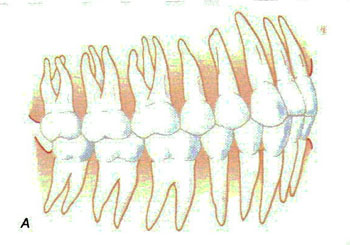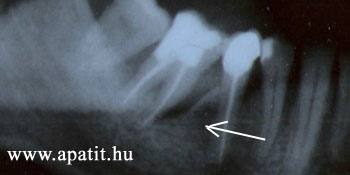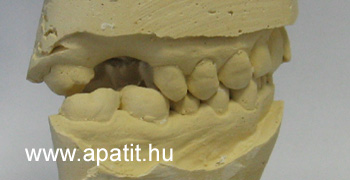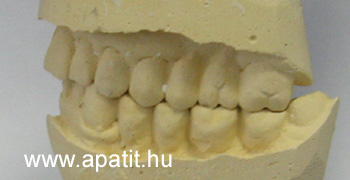Crowns and bridges
Missing teeth
Edentulous area usually occur because of tooth extraction, the rare cases when it does not grow, develop. The teeth on the one hand reduces the chewing ability, and reduces the aesthetic appearance, and causes further lesions in the masticatory system. The prosthesis was therefore designed for:
- rehabilitation the chewing ability
-aesthetic
- to prevent further negative consequence of toothmissing
Why is it important to replace a lost tooth? Even a single missing tooth can trigger a process, which later lead to further negative changes. The following examples demonstrate that how can cause a missed molar wide variety of lesions in the whole masticatory system. 1. In the direction of the extracted tooth list the behind one. It is true that third molar can so easiler erupt, but the second molar list and not shift towards the place of missing tooth. 2. Due to the inclination of the second molars periodontal disease develops in frontal root of the teeth, which eventually lead to its loss. 3. In some places, the incidence of decays may be more frequent between the teeth 4. The opposite tooth of the mising one lift, which complicated the subsequent execution of dental prostheses. 5. Because of the displacement of the teeth the occlusal area significantly reduced, and the chewing ability significantly reduced on this side . 6. Therefore, the patient use the other side for chewing. The site does not prevail in the cleansing effect of mastication and therefore it's disposed to plaque, cavity and tartar. Dentist often found tartar on the occlusal surface in the site is not used. 7. Due to the one side chewing jaw lesions may develop.
|
The missing teeth are basically two ways to replace it. The patient can not be removed by the way, permanently anchored dental prosthesis, and the patient's removable dental prosthesis (curly anchoring, combined with dentures, full dentures plate).
Fixed prosthesis
Fixed prosthesis is made by dental lab, cemented to teeth, and non-removable by patientsr. Its completion tooth preparation (grinding), impression and dental laboratory technician assistance is needed. Conditions for its use are an adequate number and location of teeth. Aesthetics and quality of life, these are the best, the price is proportionally higher.
The simplest (not professionally) prosthesis is to replace a certain part of a tooth. These can be divided into two groups:
Root canal post, which one part is in the root canal located, another truncated con shaped part replace the toothcrown, and it will be covered by ceramic crown. Root canal screw made of metal and dentist can perform the core building.
 The second group are aesthetic restorations completing or replacing of the crown of the tooth ment parts or additional. These include inlays, which are produced by a dental technician, and by dentist cemented "filling", larger onnlays or the typically for frontal teeth made thin veneers to correct color and shape. These restorations under the minimum loss of toothmaterial are aesthetic solution, but nowadays the modern aesthetic filling materials and filling techniques may be alternatives to the above treatments in less time. It can be made of gold, forcelain fused to metal, ceramic or reinforced plastic composition material.
The second group are aesthetic restorations completing or replacing of the crown of the tooth ment parts or additional. These include inlays, which are produced by a dental technician, and by dentist cemented "filling", larger onnlays or the typically for frontal teeth made thin veneers to correct color and shape. These restorations under the minimum loss of toothmaterial are aesthetic solution, but nowadays the modern aesthetic filling materials and filling techniques may be alternatives to the above treatments in less time. It can be made of gold, forcelain fused to metal, ceramic or reinforced plastic composition material.
When a tooth is destroyed so that the filling can not be fitted, a crown can restore a shape, color and function of the tooth. The coat of a fixed prosthesis on the name of a crown.
The missing tooth-related problems in many solutions exist, which is assessed by the dentist's responsibility. The missing teeth can be substituted in the fixed and / or removable dental prosthesis, implantation.
A fixed prosthesis substituing missing teeth are the bridge. The bridges are cemented to the abutment, teeth should be prepared to make it abutment. The purpose of preparation to provide space for the bridge. Abutment can be your own teeth or implants. The evolution of dental technology has been a number of methodology to produce crowns and bridges, some of which are already part of history, however, many patients have older technology bridges in his mouth. Now the porcelain fused to metal prostheses are the most commonly used procedure, which is sufficient stability and an aesthetic solution for tooth replacement. Recently, metal-free restorations are starting to spread in dental care.
To replace missing teeth -if it is possible- , the bridges are best, but bridges can only partially be restored the chewing ability. The cleaning of bridges similar to those of its own teeth, but with more care.








